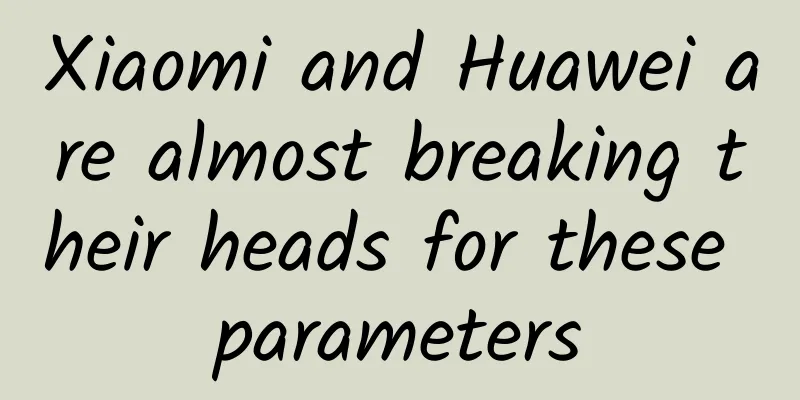Xiaomi and Huawei are almost breaking their heads for these parameters

|
Compared with the rapid growth of the mobile phone industry in 2012 and 2013, the market development last year was a bit dull, and there were not many disruptive innovative products. The drowsiness of international manufacturers handed the stage to the "hungry" domestic mobile phone manufacturers who were in the process of catching up, and the outbreak of various verbal battles also filled the entire industry with a stronger smell of gunpowder. If 2014 is defined as a "bad year" for the mobile phone industry, then 2015 should be a "big year". We witnessed the awakening of international manufacturers at CES and MWC, and the return of flagship products such as Samsung S6, HTC One M9, and LG G Flex 2 seemed to have brought back the innovation and passion we had lost for a long time. As the smartphone market becomes increasingly saturated, the importance of innovation is self-evident. As a result, more and more products are shifting from "big and comprehensive" to "small and exquisite", hoping that the products can find a breakthrough point in a certain market segment. In this article, we will start with the selling points of the mobile phone manufacturers' PK, and take stock of the representative smartphones and the pros and cons they cause in the process of user use. Screen: The 2K era is coming, and the curved screen is just the beginning
Since the launch of Samsung Note, large screen size has gradually become a popular selling point in the market segment. From the user level, it has become a trend. When the screen size increases from 4 inches to 5 to 6 inches, manufacturers begin to make a fuss about resolution and launch higher pixel, such as 2K screen mobile phones to attract users. Representative products include: Samsung S6/S6 edge, Samsung Note 4/Note Edge, HTC One M9+, Moto X Pro, LG G3, OPPO Find 7, vivo Xplay 3S, Lenovo VIBE Z2 Pro, Coolpad Grandview Platinum, etc. All of the above products are 2K screen products that have been officially released, among which international brands and domestic mobile phones are equally popular. For consumers, 2K screens can bring more detailed resolution display effects, and are clearer than ordinary 1080P screens when viewing text or pictures, but this will cause the problem of faster power consumption, so users need to make targeted trade-offs when choosing. In order to seek differentiation, we see that Samsung and LG have begun to seek innovation in screen display modes and launched curved screen mobile phones. The advantage of this screen is that it can better utilize the screen space to simplify operations. However, users have not yet fully accepted this new operating method, and there are not many exclusive applications for the curved side screen. Appearance: Are you optimistic about borderless phones?
Many mobile phone enthusiasts will never forget the excitement they felt when they saw the borderless mobile phone Sharp Aquos Crystal. Last year, especially when the appearance of smartphones was in the stage of imitation and plagiarism, the appearance of this borderless mobile phone made people feel that it was a conceptual design full of technology. The development of borderless technology has been a gradual process. Two years ago, Meizu first proposed a design theory of ultra-narrow borders on its Meizu MX series of mobile phones. Borderless design was only mentioned this year. This time, domestic mobile phones are once again ahead of international manufacturers. The LeTV mobile phone released not long ago and the nubia Z9 to be released in May both advertise the use of borderless design. Smartphones have entered the era of "looking at the face". I think this sentence is more appropriate to describe the industrial design of mobile phones today. In today's world where hardware cannot be distinguished, using the "novel appearance" of borderless phones to attract consumers is indeed another weapon for manufacturers to focus on the market segment. Furthermore, when using borderless phones, users can experience the advantages of a higher screen-to-body ratio, which will inevitably lead to a breakthrough in entertainment experience. Of course, how borderless phones can solve problems such as accidental touches on the edges and fragile screens is still a difficult problem. In addition to the most controversial borderless design, the competition among mobile phone manufacturers in appearance is also reflected in ultra-thin design, plastic/metal body, and customized appearance. In order to meet the preferences of more users, the Moto X, which supports customized options, has set a benchmark, and the splicing method of Google's Project Ara modular mobile phone also seems to indicate that the appearance of future mobile phones may once again subvert human vision. Performance: 64-bit chips are becoming more common, but their advantages are not yet apparent
In 2013, Apple first installed a 64-bit A7 processor on the iPhone 5s. In the following year, Android chip manufacturers Qualcomm, Samsung Orion, Intel, MediaTek, and HiSilicon quickly followed suit and launched 64-bit chip CPUs in the high-end and mid-range markets. Some representative products include: A7/A8: Apple iPhone 5s, iPhone 6, iPhone 6 Plus; Snapdragon 810: HTC One M9, nubia Z9 Max, LeTV Superphone 1 Pro/Max; Snapdragon 615: Samsung A7, HTC Desire 826, nubia Z9 mini, vivo X5Max, OPPO R5, Coolpad Dasheng F2; Snapdragon 410: ZTE V5Max/V5S, Lenovo Lemon K3, Huawei Honor 4X, Huawei G7; Samsung Exynos 7 Octa: Samsung S6, S6 edge; Intel Z3560: Lenovo P90, Asus ZenFone 2; MediaTek MT6752: HTC One M9+ (MT6795T), Meizu Note, Lenovo Lemon K3 Note, Gionee ELIFE S7, OPPO U3, Meitu M4; Kirin 930/935: Huawei P8/Max, Huawei Honor X2. From single-core to current octa-core, and then to 64-bit chip upgrades, CPU has always been one of the biggest selling points of mobile phone products. Entering 2015, 64-bit chips have occupied half of the market. 64-bit processors have made great improvements in registers and storage, and most of them are upgraded based on ARMv8. ARMv8's improvements include processor speed, multimedia processing speed, etc., and it is also one to two times faster than ARMv7 in file encryption and decryption. Therefore, the arrival of 64-bit ARMv8 will make the processor's performance and working range faster and wider. The ARMv8 architecture improves the operating speed and efficiency of 64-bit chips, rather than just a 64-bit chip. Apart from the high-end 64-bit processors which have a significant performance advantage, other 64-bit chips do not have much difference in operating experience. Moreover, 4GB of mobile phone memory is not yet popular, and applications are not fully compatible with 64-bit chips. This obviously still requires some time to accumulate. Fingerprint: Combining with mobile payment is the key
Fingerprint recognition is not a new technology in the technology industry. Motorola launched the ME860, a product with a fingerprint recognition module, a long time ago, but it was not popularized due to the cumbersome recognition process. It was not until the improvement of the press-type fingerprint recognition technology began to be slowly used in iPhone and Android mobile phone products that people began to pay attention to fingerprint recognition technology. Compared with those sliding fingerprint recognition modes, the press-type fingerprint recognition technology has a faster recognition speed and higher accuracy. Currently, representative products with press-type fingerprint recognition include: iPhone 5s, iPhone 6/6 Plus, Samsung S6, S6 edge, HTC One M9+, Huawei Mate 7, Meizu MX4 Pro, LeTV Superphone 1 Pro/Max, OPPO N3, etc. Although fingerprint recognition technology is very cool, it can only be used for unlocking and purchasing software in the App Store, and it has not been fully opened to third parties, so at least at this stage it has not played a big role. However, considering the combination of fingerprint technology and payment technology in the future, payment solutions similar to Apple Pay and Android Pay will gradually be launched, and then the fingerprint recognition function will explode. Sound effects: HiFi technology for audiophiles If you ask which products will be ended by smartphones, then traditional music players must be one of them. Generally speaking, when a mobile phone plays music, the CPU will read the audio file on the flash memory through the system and convert it into a digital signal to the digital-to-analog conversion chip. The chip will then be responsible for converting the digital signal into an analog signal, and then transmit the amplified analog signal to the headphones or speakers for playback. The whole process determines the final sound quality. In order to highlight the sound quality, some HiFi-focused mobile phones began to appear in people's field of vision. Representative HiFi products at this stage include: vivo Xplay3S, vivo X5Max, Meizu MX4 Pro, Smartisan T1, etc. Since mobile phone manufacturers have started to talk about HiFi, what exactly is it? HiFi actually means high fidelity, or more precisely, it is the playback sound that is highly similar to the original sound. This is different from the general sense of hearing, which is more of a subjective effect, while HiFi determines the objective sound quality effect. Ordinary smartphones are usually built with cheap codec chips, while HiFi phones use more professional chips for SRC (sampling frequency conversion), DAC (digital-to-analog converter) and independent op amp chips, while ordinary codecs are integrated op amps. In addition, different HiFi phones have different choices of the three, which is also the standard for distinguishing HiFi phones. If you are a professional audiophile, then it is necessary to choose a HiFi phone. In addition to the HiFi itself, you also need to equip yourself with a good pair of headphones and download higher-quality audio files. But for ordinary users or those with low ear recognition ability, then choosing an ordinary phone is completely sufficient. Battery: Capacity is the bottleneck, flash charging is innovative Unlike the ever-increasing hardware configurations, the battery has always been a common problem for mobile phones, and users have to get used to charging their phones once a day. To solve this problem, some products have begun to be equipped with larger capacity batteries, while adding technologies such as smart power saving and flash charging to the system. Representative mobile phones equipped with larger battery capacity include: iPhone 6 Plus, Huawei Mate 7, Huawei Honor X2, Lenovo VIBE Z2 Pro, and nubia X6. At present, there are two main flash charging technologies: VOOC and Qualcomm Quick Charge 2.0. Products with flash charging technology include: OPPO Find 7, OPPO N3, OnePlus, Samsung S6/S6 edge. A larger battery capacity can ensure longer usage time under the same hardware configuration, while the smart power saving mode adds power saving technology to the system itself, saving power by shutting down unnecessary background software. As for the flash charging technology, it allows users to quickly charge within a certain period of time to improve efficiency. In addition, don't forget wireless charging, which is also a pragmatic way of charging that allows you to abandon data cables. Therefore, when users choose a smartphone, these invisible factors must not be ignored. Camera: The dual camera upgrade is not obvious
As the main selling point, mobile phone cameras have been caught in an endless pixel competition for a long time. Nokia is the representative of this. They have launched 41-megapixel Nokia 808, Nokia Lumia 1020 and other camera phones. However, the adverse effect caused by this is that many consumers will misunderstand that the higher the pixel of the mobile phone camera, the better the photo effect. In fact, this is not the case. The imaging effect is largely determined by the size of the CMOS sensor of the mobile phone camera and the adjustment of the sample. After a period of market fluctuations, smartphone camera pixels eventually converged between 10 and 20 megapixels. By the end of 2014, smartphone manufacturers began to promote the concept of dual cameras, and some representative products include: HTC One M8, Huawei Honor 6 Plus, and Coolpad Platinum. Simply put, the role of the dual camera is to use two cameras to form images at the same time, and the lenses are used for shooting and detecting depth of field respectively, so as to achieve higher image quality and better depth of field blur effect, and software can also be used for refocusing. However, the concept of dual cameras has not been accepted by the industry yet. Through comparison, we found that the improvement in image quality of dual cameras compared to single cameras is not obvious, and some post-production algorithms also need further optimization. It is not recommended for consumers to choose it at this stage. UI: Same interface, content is king
Compared to the closed iOS system, the Android system has always been plagued by the problem of serious homogeneity. When hardware development reaches a certain bottleneck period, the system becomes a reference factor for users to choose products to a large extent. In recent years, almost all mobile phone manufacturers have begun to carry out system customization design. However, there are also some commonalities among them, such as the interface style is now close to flat design, and there are many similarities in functions. Of course, it is not enough to just customize the system. Ultimately, Android manufacturers need to find differentiation in the cloud and content. If they want to realize the ecosystem of smartphones, the system level is a very important link. In addition, the system itself still has a lot of room for development, including system compatibility, stability, etc. The system level is the most direct contact for users when using their phones every day, so before buying a phone, you must make sure whether its interactive interface is your cup of tea. Price: 1,000 yuan/100 yuan, market potential
In addition to the hardware and software competition points mentioned above, price wars are also the main battlefield that manufacturers and products must fight. In recent years, the saturation of the high-end market has shifted the focus of the mobile phone industry to the thousand-yuan or hundred-yuan mobile phone market. According to IDC surveys, global smartphone shipments this year will continue to decline compared to previous years, and this trend will continue until 2018. At the same time, the overall price of mobile phones will also decline. This is the main reason why mobile phone manufacturers have begun to turn to the cheaper market. But what is interesting is that compared with those international brands, the low-end market can be said to have been firmly occupied by domestic mobile phones. Many low-end products can fully meet the needs of general users in terms of configuration and experience. Although the profit of these products is meager, their future profit core may lie in the system software level. Letting users pay to download applications or services will be a new profit growth point. Summary: Avoid blindly following the trend of innovative features Above we have summarized the focus of the competition among smartphone products. If the previous products were more homogeneous, now we have seen some mobile phone manufacturers begin to seek innovation. However, it is still difficult to say whether these innovations can become the standard for users to choose products. But for today's somewhat dull mobile phone industry, the significance of such innovation is greater than its actual usefulness. Since last year, at various new product launches, we rarely see the blind competition in hardware configurations. Instead, we see more of them promoting the product system experience or what unique skills they have compared to other products. In other words, the market segments we mentioned at the beginning of the article are gradually becoming the focus of efforts. For consumers, it is still necessary to carefully determine which of these PK focuses can bring practical help and which are just gimmicks. In the face of these innovative functions, what we need to do is not to blindly follow them. Rationally thinking about which selling point you value more may help you avoid some detours when choosing a smartphone. |
<<: Who is the mysterious DST? How much money did it cash out from JD.com?
Recommend
WeChat actually wants to have its own input method? Is it really necessary for WeChat to have a keyboard?
Recently, some netizens broke the news that WeCha...
These 21 points almost summarize all the problems faced by operators. Many people suddenly realize the truth after reading them!
Some time ago, I had in-depth communication and u...
praise! An inventory of creative cases in 6 major industries for information flow advertising!
During my years as a bidder, I asked myself more ...
Introduction to Wolf Totem: How to do SEO promotion and what are the channels?
As companies become more familiar with the Intern...
The United States relaxes restrictions on Chinese airlines! How many flights can be operated per week now? Attach details
China-US relations are a focus of public attentio...
Coupon rapid traffic diversion and monetization strategy
“Some leeks get used to it after a while.” Some t...
Qiu Ma said, Guangdiantong optimization basics - 5 steps to play with Tencent resources
As one of the absolute mainstream channels for AP...
In the second half of the Internet, will the traffic dividend disappear? There are 3 operating directions
In a speech this year, Xing Ge mentioned that aft...
Zheng Xiangzhou Business model + capital operation, look at other people's models to find your own opportunities
Zheng Xiangzhou Business model + capital operatio...
How much does it cost to customize the Shanghai Building Materials Mini Program? What is the price of customization of Shanghai Building Materials Mini Program?
WeChat Mini Program is an application that users ...
Startups need to clarify these 6 issues before they can do a good job of data-driven operations!
Data analysis is only taken seriously in some part...
How to promote and operate WeChat mini programs? What are the ways to promote WeChat mini programs?
It has been more than 5 years since the mini prog...
Hundreds of millions of video views per day, Miaopai playback link optimization practice
[51CTO.com original article] Currently, we are in...
How much does it cost to outsource mini program development?
What is mini program outsourcing development? How...
Android March security update will fully fix MediaTek-SU permission vulnerability
Google today reiterated the importance of keeping...









